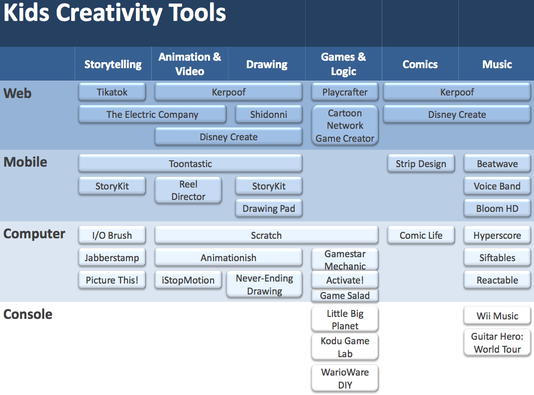UNITY
I dreamed I stood in a studio
And watched two sculptors there,
The clay they used was a young child's mind
And they finished it with care.
One was a teacher; the tools he used
Were books and music and art;
One a parent with a guiding hand
And a gentle and loving heart.
Day after day the teacher toiled
With a touch that was deft and sure
While the parent laboured by his side
And polished and smoothed it o'er.
And when at last their task was done
They were proud of what they had wrought,
For the things they had moulded into the child
Could neither be sold nor bought
And each agreed he would have failed
If he had worked alone.
For behind the parent stood the school
And behind the teacher, the home.
(Anon., 1998)
How can technology integration foster the development of children's creativity?

Some of the most widespread uses of technology in early childhood classrooms has involved digital photos, internet, and educational computer games. While these mediums are indeed useful, technology is developing rapidly and there is now so much more available. But how can teachers know what types of technologies are of worthwhile quality for fostering the development of creativity?
In a study conducted by Latitude Research, children were asked to suggest new concepts for new computer and web technologies. Interestingly, 31% of the ideas presented pertained to a tool for creating something, leading researchers to conclude that children’s aspirations for technology use involved the creation of something new (My Thai & Russell, 2010). To this end, My Thai & Russell (2010) have documented the current products available to children that begin to foster creativity:
In a study conducted by Latitude Research, children were asked to suggest new concepts for new computer and web technologies. Interestingly, 31% of the ideas presented pertained to a tool for creating something, leading researchers to conclude that children’s aspirations for technology use involved the creation of something new (My Thai & Russell, 2010). To this end, My Thai & Russell (2010) have documented the current products available to children that begin to foster creativity:
Image from My Thai & Russell, 2010.
The authors further cite the opportunities for producers to make tools that “balance scaffolding with open-ended and imaginative play” (My Thai & Russell, 2010). Several of the tools cited above and in the practical resources offer many opportunities for young children's creative expression.
To foster creativity presents a challenge for teachers, but it is one of great value to today's learners. If the students of today are to be successful in their future careers, they will require these skills. However, the issue goes beyond that. Placing value on each child's creative ideas and processes is quite possibly the most sincere level on which to connect with them. For children to understand that their work truly matters in the world, to their peers, and to themselves offers a deep and meaningful sense of community.
To foster creativity presents a challenge for teachers, but it is one of great value to today's learners. If the students of today are to be successful in their future careers, they will require these skills. However, the issue goes beyond that. Placing value on each child's creative ideas and processes is quite possibly the most sincere level on which to connect with them. For children to understand that their work truly matters in the world, to their peers, and to themselves offers a deep and meaningful sense of community.

